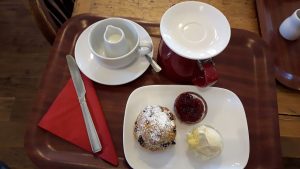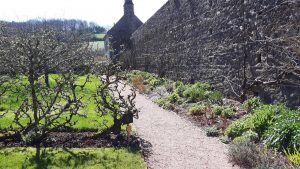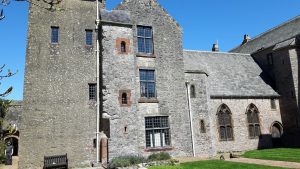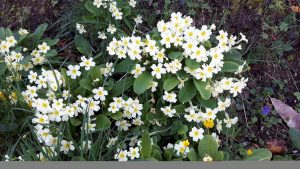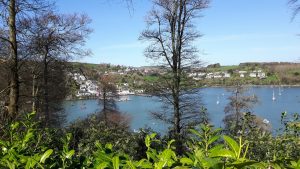Day 10
At last sunshine, and the warm winds that John Masefield wrote about. There is almost music in the poem. The first verse reads: –
“It’s a warm wind the West Wind, full of birds’ cries;
I never hear the West Wind, but tears are in my eyes.
For it comes from the west lands the old brown hills,
and April’s in the west lands and daffodils.
It’s a fine land the west land for hearts as tired as mine,
there’s apple orchards, blossom there, and the airs like wine.
There’s cool green grass there where men may lie at rest,
and the thrushes are in song there a fluting from their nests…”
I have to tell you, reader, we were on the road to Greenway, the holiday home of Agatha Christie, built in the 1700s. Everywhere we drove, those rolling green hills were seen, some laced with daffodils and other flowers, and where sheep grazed and lambs bleated.
David had booked a parking spot online since parking is limited on the property.
Greenway is a glorious place. Blossoms, magnolias, and an endless variety of trees grace winding pathways up to the house. The River Dart flows at the side of the property. The house is white and stands in majestic splendour against a backdrop of tall lush green trees. Can you imagine the chorus of bird song in such a setting?
Tourists were aplenty, a boatload disembarked at the dock, their cheerful chatter floating on the air as they made their way up the incline to the house.
We viewed the house upstairs and down. A huge collection of fine china was packed into cupboards in the kitchen and dining room. Plus, books in built-in bookshelves in every room-I think! Collectibles were displayed in cabinets and on shelves, evidence of Agatha’s extensive travels to faraway lands, especially the middle east. We learned her travels to exotic and distant places had given her fodder for many of her mystery novels.
Of note, Agatha Christie was born and raised in Torquay. Her name is known worldwide, and her books have been translated into many languages. However, we learned much that we didn’t know about her, that her first husband left her for another woman, that she later married a man 15 years her junior, and how he was a faithful and loving husband. She developed a great interest in her husband’s archeological digs and assisted him in his pursuits.
Strolling back from the house, we stopped in the courtyard where former horse stables had been converted into gift stores, washrooms, and other conveniences, one being the Tack Room where takeaway food could be purchased and consumed at tables set in the shade.
One of the horse stables remained as such. Here we watched a video of Agatha’s grandson talking about his happy vacations at Greenway.
A life-size picture of Hercule Poirot in the stable begged our attention, and we could not resist posing for photos with the famous character!
Outside the stable on the cobbled stones were two stainless steel bowls filled with water for dogs. We laughed at the notices on the wall above them. An arrow pointed to each bowl, indicating that one was caffeinated water and the other decaffeinated! We did not visit one place in England without seeing stainless steel bowls filled with water. They were set outside cafés, houses, castles, and so on, even in the malls and shopping areas. The English, literally, take their dogs everywhere. I suppose that’s what triggered Noel Coward to write, ‘Mad dogs and Englishmen go out in the midday sun!’
It was time for us to take a break, and we chose to go around the corner to the Barn Café, where we had light refreshments.
Leaving Greenway, we travelled five miles north to Compton Castle. A tiny and ancient castle with a fascinating history. Sir Maurice de la Pole owned the property during the reign of King Henry II (1154–1189). Later it became the property of Sir Peter Compton.
The original undefended manor house was built in the mid-14th century and consisted of a hall flanked by solar and service rooms at each end. These were rebuilt in the later Middle Ages. The fortress-like front was added in about 1520 by John Gilbert. The central hall was in ruins by the 18th century but was faithfully reconstructed in the 1950s.
Compton Castle’s most famous inhabitant was Sir Humphrey Gilbert.(1539–1583), coloniser of Newfoundland and half-brother of Sir Walter Raleigh; legend has it that Raleigh smoked the first pipe of tobacco in Britain while visiting Sir Humphrey. The castle was home to the Gilbert family until the estate was sold in 1785 whereupon it gradually declined until a descendent bought it back in 1931; he gave it to the National Trust in 1951 on the condition that members of the family should continue to occupy the castle.[10] They still do, and administer it for the Trust. Source: Wikipedia
An interesting fact too is the castle was used for the filming of the 1995 version of Sense and Sensibility. Needless to say, many of the National Trust sites and other sites have made excellent locations for many a movie.
We spent some time in the small rectangular garden. The rose bushes were just peeking through, and evidence of a garden full of flowers was a sure thing, not many days hence.
Dartmoor.
The sun continued to shine. David decided we should continue north and go back to Dartmoor, and what a difference. The Dartmoor ponies were in full view. One ambled into the middle of the road and stood there. Out came our cameras. Hilary got several good shots.
Situated in the south west of England, right in the very heart of Devon, Dartmoor is an ancient landscape of stunning views, awe inspiring granite tors, deep wooded valleys with fast flowing rivers, and rugged, wide open spaces.
Dartmoor Ponies are an iconic sight, living as semi-wild herds all over the moor. Where else can you see the wonderful sight of wild pony foals playing together against a backdrop of one of the most stunningly beautiful areas in the UK? Source: Dartmoor web site.
Dartmoor’s history is impressive, we learned, for example, hut circles can be seen on the moors and are the ruins of pre-historic houses from the Neolithic age. The first settlers lived on the moors 5000 years ago. In 1336 King Edward 111 made his son, who was the Prince of Wales, the first Duke of Cornwall and gave him Dartmoor. The present Duke is Prince Charles of Wales.
On to the village of Widdecombe-in-the-Moor. A delightful village! Schoolchildren were playing on the green or chatting in groups. The green was surrounded by cottages and various buildings. The church stood out from all the rest and was believed to have been built in the 1300s. A tour bus pulled in with a group of teenagers. David determined they were speaking Ukrainian.
With tummies rolling, our eyes were drawn to the Café-on-the-Green, and without further ado, we were soon sitting down at a table on the patio consuming, hot scones with clotted cream and strawberry jam. And of course, a cuppa too! To top off this pleasant break, the church bells were ringing. With a visit to the church, later on, we learned the bell ringers were practicing for a wedding that was to take place the next day.
There is a song, well known to British children about an Uncle Tom Cobley and several fellows who rode a grey mare to Widdecombe fair. Needless to say, David, Hilary, and I were singing it and trying to remember the words. Here is the first verse, and the song goes on in the same vane for several more verses. If at any time you would like us to give you a rendition, I’m sure we can arrange it!
Tom Pearce, Tom Pearce, lend me your grey mare
All along, down along, out along lee.
For I want to go down to Widecombe Fair
Wi’ Bill Brewer, Jan Stewer, Peter Gurney,
Peter Davy, Dan’l Whiddon, Harry Hawk,
Old Uncle Tom Cobley and all
Old Uncle Tom Cobley and all
Widecombe Fair attracts many tourists every year. Reading our information booklet, it was surprising to see the number of places to stay, from campsites, B&Bs, to Inns and hotels, and as noted before, dogs welcomed!

